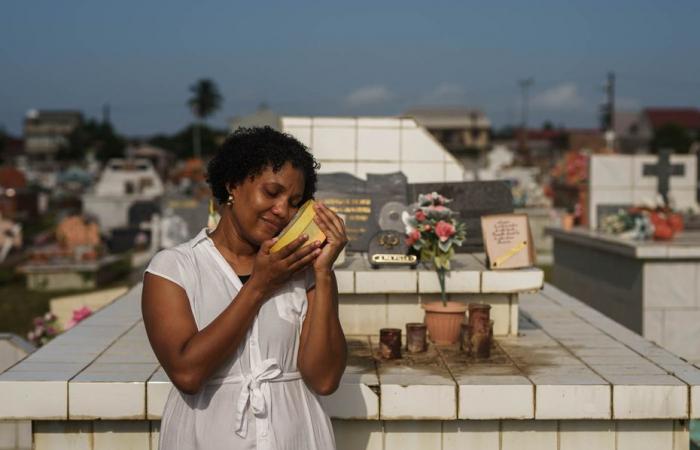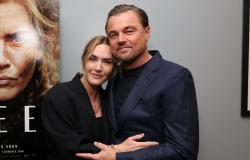In cemeteries at this time of year, several “mam’anges” as they are sometimes called, will flower the graves. They have lost a child, at birth, or in utero. To pay tribute to them and talk about their experience, an exhibition, produced by the photographer, Anne-Sophie Bender, is visible until mid-November at the Cayenne Hospital Center. Sabine, Lucie and Vanessa, all mothers of these “baby angels” confide.
It’s an unexpected photo exhibition in this place. We are at the entrance to the Women and Children Center, at the Cayenne Hospital Center. There, every day, mothers are born, at the moment when they give birth. But this is not what Anne-Sophie Baden chose to highlight through these photos, the prints of which were financed by the Périnat Network. Here, the photographer shows everyone that in this place too, sometimes, women lost their children. “I wanted, through this exhibition, to lift the taboo on perinatal mourning, terminated pregnancies and voluntary terminations of pregnancies. »
The approach is unprecedented. The photos, striking in their poetry, their light, their message quite simply. Here, a woman holding a nonexistent baby in her arms. There, another whose hand seems to have difficulty letting fly a balloon which stands out against the blue of the sky.
•
©Anne-Sophie Bender
Sabine poses in the middle of the cemetery. “For me,” says the young woman, “it’s a soothing place where I came to take refuge a lot, especially at the beginning. There’s no noise, it’s quiet. You are there, alone with your thoughts. This is the place of our Reunion with Naevia. » In the photo, the mother holds in the palm of her hands the box which contained the comforter that she placed next to her baby’s body ten years ago.
This photo shoot was a gift to both of us. A way to say that we love each other and that we will always love each other
“When you lose a child like that, you tend to shut down and not talk about it. You want to try to digest the story in your corner, without talking about it because it embarrasses people to talk about the death of a child, like that. Posing for this photo was a way of paying tribute to her, to my daughter. Because no one knew her and she existed and still exists in my life and in my heart. For me, this photo shoot was a gift to both of us. A way of saying that we love each other and that we will always love each other. »
•
©Audrey Virassamy
The idea of having women who had to deal with perinatal bereavement pose was born gradually. When she lived in Dijon, Anne-Sophie Bender discovered the Souvenange association. This offers parents of deceased babies quality photos, retouched if necessary to erase the hospital environment, among other things. Subsequently settling in Reunion Island, she took her first photos for Souvenange. Subsequently arriving in Guyana, she discovered the therapeutic power of photos with the Endo Amazones association which fights against endometriosis. She then decided to transpose this approach to perinatal mourning.
This therapeutic aspect of photography was a surprise for Sabine. “It’s been ten years. I thought the pain was gone, but in reality, there was still a little pain in my heart… It was difficult at the time. I cried for what I experienced, that I am still experiencing. I was also happy to express that she still lives in me, through my other children. We talk about it very freely with them.”
To set up her photo exhibition, Anne-Sophie Baden sends an email to several Facebook pages. Several mothers are making themselves known. 41 photos will be taken. Each woman also provides written testimony.
I wanted this photo to be with my daughter Zoé
Like Sabine, Lucie is one of those mothers who told their story. “I wanted to take my photo in Loyola, in the forest, to rediscover the nature and strength of uprooted trees. I wanted this photo to be with my daughter Zoé. There are no taboos about her sister, Inaya: we talk about it together. It was also important for her to take this photo with her sister in mind. »
•
©Ann-Sophie Bender
In order to help women, the maternity ward offers mourning boxes where parents can bring together various objects related to the baby: photos, prints, booklets, etc. “ This exhibition corresponds to something that the hospital has wanted to do for a long time to lift this taboo on perinatal care.indicates Vanessa Massol, coordinating midwife. But we didn’t know in what form to do it.”
From now on, the support will go further: since October, an agreement has linked the Cayenne hospital and the Souvenange association which will be able to offer its services to families affected by perinatal bereavement.
“When we talk about the Women and Children Center, we think of births, not deathspoints out Vanessa Massol. However, many women who come here are confronted with it…” The health professional knows only too well what she is talking about. She recounts this appointment for a second trimester ultrasound while she was expecting her fourth child.
I lived my life normally for two days at home thinking maybe my uterus was a coffin
“At that moment, the sonographer told me: “There is no heart”. I got off the table. I called my gynecologist who asked me to come quickly. My colleague took the various samples and I was prescribed the medication. I came home. I went to a friend’s son’s birthday. My day went as it should. You have to keep smiling. head up and continue for the children. I lived my life normally for two days at home, telling myself that my uterus was perhaps a coffin. And I gave birth at night…It happened quickly. went to the operating room, I went back to my room The next morning, I came home as quickly as I arrived… And then we had to continue for the children, for everyone. »
For Anne-Sophie Bender’s photo, Vanessa is standing with a small bodysuit against her stomach. In black letters, with a bright red heart, it indicates: « Mum and Dad love me ».
•
©Anne-Sophie Bender






